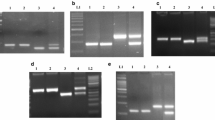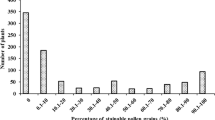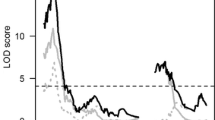Abstract
The Wild Abortive (WA) system is the major cytoplasmic male sterility (CMS) source for hybrid rice production in indica rice and its fertility restoration is reported to be controlled by two major loci viz. Rf3 on chromosome 1 and Rf4 on chromosome 10. With the availability of the rice genome sequence, an attempt was made to fine map, develop candidate gene based markers for Rf3 and Rf4 and validate the developed marker system in a set of known restorer lines. Using polymorphic markers developed from microsatellite markers and candidate gene based markers from Rf3 and Rf4 loci, local linkage maps were constructed in two mapping populations of ~1,500 F2 progeny from KRH2 (IR58025A/KMR3R) and DRRH2 (IR68897A/DR714-1-2R) hybrids. QTLs and their interactions for fertility restoration in Rf3 and Rf4 loci were identified. The identified QTL in both mapping populations together explained 66–72 % of the phenotypic variance of the trait suggesting their utility in developing a marker system for identification of fertility restorers for WA-CMS. Sequence comparison of the two candidate genes from the Rf3 and Rf4 regions in male sterile (A) and restorer (R) lines showed 2–3 bp indels and a few substitutions in the Rf3 region and indels of 327 and 106 bp in the Rf4 region respectively. The marker system identified in the present study was validated in 212 restorers and 34 maintainers along with earlier reported markers for fertility restoration of WA-CMS. Together DRCG-RF4-14 and DRCG-RF4-8 for the Rf4 locus and DRRM-RF3-5/DRRM-RF3-10 for the Rf3 locus showed a maximum efficiency of 92 % for identification of restorers.




Similar content being viewed by others
References
Ahmadikhah A, Alavi M (2009) A cold-inducible modifier QTL affecting fertility restoration of WA CMS in rice. Int J Genet Mol Biol 1:89–93
Ahmadikhah A, Karlov GI (2006) Molecular mapping of fertility restoration gene Rf4 for WA-cytoplasmic male sterility in rice. Plant Breed 125:363–367
Ahmadikhah A, Karlov GI, Nematzadeh GH, Ghasemi Bezdi K (2007) Inheritance of the fertility restoration and genotyping of rice lines at the restoring fertility (Rf) loci using molecular markers. Int J Plant Prod 1(1):13–21
Allard RW (1956) Formulas and tables to facilitate the calculation of recombination values in heredity. Hilgardia 24:235–278
Bazrkar L, Ali AJ, Babaeian NA, Ebadi AA, Allahgholipour M, Kazemitavar K, Nematzadeh G (2008) Tagging of four fertility restorer loci for wild abortive cytoplasmic male sterility system in rice (Oryza sativa L.) using microsatellite markers. Euphytica 164:669–677
Benson G (1999) Tandem repeat finder: a program to analyze DNA sequences. Nuclic Acids Res 27:573–580
Bharaj TS, Bains SS, Sidhu GS, Gagneja MR (1991) Genetics of fertility restoration of ‘Wild Abortive’ cytoplasmic male sterility in rice (Oryza sativa L.). Euphytica 56:199–203
Fujii S, Toriyama K (2009) Suppressed expression of RETROGRADE-REGULATED MALE STERILITY restores pollen fertility in cytoplasmic male sterile rice plants. Proc Natl Acad Sci USA 106(23):9513–9518
Gao MW (1981) A preliminary analysis of genotype of hybrid hsien rice with wild rice cytoplasm. Acta Genet Sin 8(1):66–74
Govinda Raj K, Virmani SS (1988) Genetics of fertility restoration of WA type cytoplasmic male sterility in rice. Crop Sci 28:787–792
Hanson MR, Bentolila S (2004) Interactions of mitochondrial and nuclear genes that affect male gametophytic development. Plant Cell 16:S154–S169
He GH, Wang WM, Liu GQ, Hou L, Xiao YH, Tang M, Yang ZL, Pei Y (2002) Mapping of two fertility restoring genes for WA cytoplasmic male sterility in Minghui63 using SSR markers. Acta Genet Sin 29(9):798–802
Henke W, Herdel K, Jung K, Schnorr D, Loening SA (1997) Betaine improves the PCR amplification of GC rich DNA sequences. Nucleic Acids Res 25(19):3957–3958
Hossain MD, Singh AK, Zaman F (2010) Genetics of fertility restoration of ‘WA’ based cytoplasmic male sterility system in rice (Oryza sativa L.) using indica/japonica derivative restorers. Sci Asia 36:94–99
Huang ZS (1987) Genetics analysis of indica rice CMS male sterile resloring gene. Zhonghua Nongye Yanjiu 36(2):37–150
Huang QY, He QY, Jing RC, Zhu RS, Zhu YG (2000) Mapping of the nuclear fertility restorer gene for HL cytoplasmic male sterility in rice using microsatellite markers. Chin Sci Bull 45:430–432
IRRI (International Rice Research Institute) (1996) Standard evaluation system for rice, 4th edn. IRRI, Los Banos (Philippines)
Itabashi E, Iwata N, Fujii S, Kazama T, Toriyama K (2011) The fertility restorer gene, Rf2, for Lead Rice-type cytoplasmic male sterility of rice encodes a mitochondrial glycine rich protein. Plant J 65(3):359–367
Jing R, Li X, Yi P, Zhu Y (2001) Mapping of fertility restoring genes of rice WA cytoplasmic male sterility using SSLP markers. Bot Bull Acad Sin 42:167–171
Juan JZ, Yu xiang Z, Dali Z, Liang yong MA, Xi ming LI, Bing xin LIU, Chang deng Y (2010) Identification of QTLs for rice cold tolerance identified at plumule and 3-leaf-seedling stages using QTLNetwork software. Rice Sci 17(4):282–287
Komori T, Ohta S, Murai N, Takakura Y, Kuraya Y, Suzuki S, Hiei Y, Imaseki H, Nitta N (2004) Map-based cloning of a fertility restorer gene, Rf-1, in rice (Oryza sativa L.). Plant J 37:315–325
Kosambi DD (1944) The estimation of map distance from recombination value. Ann Eugen 12:172–175
Kumar S, Chakrabarti SN (1983) Genetic and cytogenetic analysis of spikelet sterility in indica japonica crosses in Oryza sativa L. Indian J Genet Plant Breed 60:441–450
Li JM, Yuan LP (2000) Hybrid rice: genetics, breeding, and seed production. Plant Breed Rev 17:15–158
Liu XQ, Xu X, Tan YP, Li SQ, Hu J, Huang JY, Yang DC, Li YS, Zhu YG (2004) Inheritance and molecular mapping of two fertility restoring loci for Honglian gametophytic cytoplasmic male sterility in rice (Oryza sativa L.). Mol Gen Genomics 271:586–594
Lorieux M (2007) MapDisto: a free user friendly program for computing genetic maps. Computer demonstration given at the Plant and Animal Genome XV conference, Jan 13–17 2007, San Diego, CA. URL: http://mapdisto.free.fr/
Mishra GP, Singh RK, Mohapatra T, Singh AK, Prabhu KV, Zaman FU, Sharma RK (2003) Molecular mapping of a gene for fertility restoration of wild abortive (WA) cytoplasmic male sterility using a basmati rice restorer line. J Plant Biochem Biotechnol 12:37–42
Nandi S, Subudhi PK, Senadhira D, Manigbas NL, Sen Mandi S, Huang N (1997) Mapping QTLs for submergence tolerance in rice by AFLP analysis and selective genotyping. Mol Gen Genet 255:1–8
Nas TMS, Casal CL, Li Z, Virmani SS (2003) Application of molecular markers for identification of restorers. Rice Genet Newsl 20:69–71
Nematzadeh Gh, Kiani G (2010) Genetic analysis of fertility restoration genes for WA type cytoplasmic male sterility in Iranian restorer rice line DN-33-18. African J Biotechnology 9(38):6273–6277
Ngangkham U, De Sandip, Singh SK, Parida SK, Raj Kumar KA, Singh AK, Mohapatra T (2010) Genic markers for wild abortive (WA) cytoplasm based male sterility and its fertility restoration in rice. Mol Breed 26(2):275–292
Sarkar CKG, Fu Z, Singh AK (2002) Genetics of fertility restoration of WA based cytoplasmic male sterility system in rice (Oryza sativa L.) using basmati restorer lines. Indian. J Genet 62(4):305–308
Sattari M, Kathiresan A, Gregorio G, Hernandez JE, Nas TM, Virmani SS (2007) Development and use of a two-gene marker-aided selection system for fertility restorer genes in rice. Euphytica 153:35–42
Sattari M, Kathiresan A, Gregorio G, Virmani SS (2008) Comparative genetic analysis and molecular mapping of fertility restoration genes for WA Dissi, and Gambiaca cytoplasmic male sterility systems in rice. Euphytica 160:305–315
Sharma VK, Singh VP, Singh AK, Zaman FU (2001) Inheritance pattern of spikelet fertility restoration in hybrid rice. Indian J Genet 61(2):160–161
Sheeba NK, Viraktamath BC, Sivaramakrishnan S, Gangashetti MG, Pawan K, Sundaram RM (2009) Validation of molecular markers linked to fertility restorer gene(s) for WA-CMS lines of rice. Euphytica 167:217–227
Shen Y, Cai Q, Gao M, Wang X (1996) Isolation and genetic characterization of a fertility restoring revertant induced from cytoplasmic male sterile rice. Euphytica 90:17–23
Shen Y, Guang ZQ, Lu J, Zhuang LY, Zheng KL, Gao MW, Wang XM (1998) Linkage analysis of a fertility restoring mutant generated form CMS rice. Theor Appl Genet 97:261–266
Shinjyo C, Sato S (1994) Chromosomal location of fertility-restoring gene Rf2. Rice Genet Newsl 11:93–95
Singh AK, Mahapatra T, Prabhu KV, Singh VP, Zaman FU, Mishra GP, Nandakumar N, Joseph M, Gopalakrishnan S, Aparajita G, Tyagi NK, Prakash P, Sharma RK, Shab US, Singh SK (2005) Application of molecular markers in rice breeding: progress at IARI. Advances in marker assisted selection workshop. Trainee’s manual, Handouts and references
Sohu VS, Phul PS (1995) Inheritance of fertility restoration of three sources of cytoplasmic male sterility in rice. J Genet Breed 49:93–96
Tan XL, Vanavichit A, Amornsilpa S, Trangoonrung S (1998) Genetic analysis of rice CMS-WA fertility restoration based on QTL mapping. Theor Appl Genet 96:994–999
Virmani SS, Viraktamath BC, Casa CL, Toledo RS, Lopez MT, Manalo JO (1997) Hybrid rice breeding manual. IRRI, Philippines, p 139
Virmani SS, Mao CX, Hardy B (eds) (2003) Hybrid rice for food security, poverty alleviation, and environmental protection. Proceedings of the 4th international symposium on hybrid rice, Hanoi, Vietnam, 14–17 May 2002. Los Banos (Philippines): IRRI, 407 pp
Waghmode BD, Mehta1 HD (2011) Genetics of fertility restoration of diverse cytosterile sources in rice (Oryza sativa L.) Indian J Genet 71(1):1–8
Wang Z, Zou Y, Li X, Zhang Q, Chen L, Wu H, Su D, Chen Y, Guo J, Luo D, Long Y, Zhong Y, Liu YG (2006) Cytoplasmic male sterility of rice with Boro II cytoplasm is caused by a cytotoxic peptide and is restored by two related PPR motif genes via distinct modes of mRNA silencing. Plant Cell 18:676–687
Wang SC, Basten J, Zeng ZB (2010) Windows QTL Cartographer 2.5. Department of Statistics. North Carolina State University, Raleigh, NC. http://statgen.ncsu.edu/qtlcart/WQTL.Cart.htm
Yang J, Hu Ch, Hu H, Rongdong Yu, Xia Zhen, Ye Xiuzi, Zhu Jun (2008) QTLNetwork: mapping and visualizing genetic architecture of complex traits in experimental populations. Bioinformatics 24(5):721–723
Yao FY, Xu CG, Yu SB, Li JX, Gao YJ, Li XH, Zhang Q (1997) Mapping and genetic analysis of two fertility restorer loci in the wild abortive cytoplasmic male sterility system of rice (Oryza sativa L.). Euphytica 98:183–187
Zhang Q, Bharaj TS, Virmani SS, Huang H (1997) Mapping of the Rf3 nuclear fertility restoring gene for WA cytoplasmic male sterility in rice using RAPD and RFLP markers. Theor Appl Genet 94:27–33
Zhang QY, Liu YG, Mei MT (2002) Molecular mapping of the fertility restorer gene Rf4 for WA cytoplasmic male sterility. Acta Genet Sin 29:1001–1004
Zheng KL, Subudhi PK, Dmingo J, Magpantag G, Huang N (1995) Rapid DNA isolation for marker assisted selection in rice breeding. Rice Genet Newsl 12:255–257
Zhuang JY, Fan YY, Wu JL, Xia YW, Zheng KL (2000) Mapping major and minor QTL for rice CMS-WA fertility restoration. Rice Genet Newsl 17:56–58
Acknowledgments
The authors thank Department of Science and Technology, Government of India for the research grant and the two reviewers for suggestions and improvements.
Author information
Authors and Affiliations
Corresponding author
Electronic supplementary material
Below is the link to the electronic supplementary material.
Rights and permissions
About this article
Cite this article
Balaji Suresh, P., Srikanth, B., Hemanth Kishore, V. et al. Fine mapping of Rf3 and Rf4 fertility restorer loci of WA-CMS of rice (Oryza sativa L.) and validation of the developed marker system for identification of restorer lines. Euphytica 187, 421–435 (2012). https://doi.org/10.1007/s10681-012-0737-6
Received:
Accepted:
Published:
Issue Date:
DOI: https://doi.org/10.1007/s10681-012-0737-6




